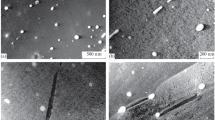Abstract
In order to improve the security and increase the discharge burnup of the reactor, nuclear materials UN and U3Si2 have been considered for their higher densities and breeding ratios compared with uranium dioxide. A specific modeling of Tristructural isotropic particles with UN and U3Si2 as nuclear fuels was developed, and its failure probability was evaluated under irradiation conditions typical of a Molten Salt Reactor. The dimensional changes of the fuel particle kernel and layers were given. The stresses in the pyrolytic carbon and silicon carbide layers caused by the kernel gas pressure under normal operating conditions are calculated alone with the failure probability of the coated particle. The finding of this study will facilitate the development of new coated particulate fuels as well as support fuel parameters for design and construction of nuclear reactors.






Similar content being viewed by others
References
Koster A, Matzner HD, Nicholsi DR (2003) PBMR Design for the Future. Nucl Eng Des 222:2–3
Terrani KA, Jolly BC, Harp JM (2020) Uranium nitride tristructural-isotropic fuel particle. J Nucl Mater 531:152034
Hakim AR, Harto AW, Agung A (2019) Neutronic analysis of fuel assembly design in Small-PWR using uranium mononitride fully ceramic micro-encapsulated fuel using SCALE and Serpent codes. Nucl Eng Technol 511:1–12
Jayabun SK, Pathak S, Rajeswari B, Bhoir S, Sengupta A (2022) ICP-OES based methodology for determination of critical elements in U3Si2 matrix. J Radioanal Nucl Chem 331:2117–2123
Ma BM (1983) Nuclear reactor materials and applications. Van Nostrand Reinhold Company, New York
Richter K, Sari C (1991) Investigation of the operational limits of uranium-plutonium nitride fuels. J Nucl Mater 184(3):167–176
Thetford R, Mignanelli M (2003) The chemistry and physics of modelling nitride fuels for transmutation. J Nucl Mater 320(1–2):44–53
Routbort JL, Singh RN (1975) Elastic, diffusional, and mechanical properties of carbide and nitride nuclear fuels-a review. J Nucl Mater 58:78–114
Feng Bo, Karahan A, Kazimi MS (2012) Steady-state fuel behavior modeling of nitride fuels in FRAPCON-EP. J Nucl Mater 427:30–38
Lin J, Zhu T, Zhang H (2014) Performance of coated particle fuel in a thorium molten salt reactor with solid fuel. Proc HTR: 31–262
Allelein HJ (1983) The behavior of HTR fuel under irradiation. SMiRT 7-Chicago, USA
K Bongartz (1980) Status of the fuel stress and failure rate calculation at KFA. KFA Rep, Juel-1686: 1–29
Kania MJ, Nabielek H, Nickel H (2009) Coated particles for the HTR, 5th edn. Wiley-VCH, Baden-Württemberg, Germany
Wagner-Löffler M (1977) Amoeba behavior of UO2 coated particle fuel. Nucl Tech 35:392–402
Verfondern K, Nabielek H (1985) PANAMA: Ein Rechenprogramm zur Vorhersage des Partikelbruchanteils von Triso Partikeln unter Störfallbedingungen, Forschungszentrum Jülich Report Jül-Spez-298
Tianbao Z (2013) Analysis of failure probability of TMSR-SF1 Coated Particle Fuel. Technical Report: XDA02030500, Shanghai Institute of Applied Physics, Chinese Academy of Sciences
Collin BP (2014) Modeling and analysis of UN TRISO fuel for LWR application using the PARFUME code. J Nucl Mater 451:65–77
Maki JT, Petti DA, Knudson DL, Miller GK (2007) The challenges associated with high burnup, high temperature and accelerated irradiation for TRISO-coated particle fuel. J Nucl Mater 371:270–280
Heit W et al (1985) Status of qualification of high-temperature reactor fuel element spheres. Nuch Tech 69(1):44–54
He J, Zou Y et al (2003) Fabrication of spherical fuel element for 10 MW high temperature gas-cooled reactor. At Energy Sci Technol 37(S1):40–40
Author information
Authors and Affiliations
Corresponding author
Ethics declarations
Conflict of interest
We declare that we have no conflict of interest.
Additional information
Publisher's Note
Springer Nature remains neutral with regard to jurisdictional claims in published maps and institutional affiliations.
Rights and permissions
Springer Nature or its licensor (e.g. a society or other partner) holds exclusive rights to this article under a publishing agreement with the author(s) or other rightsholder(s); author self-archiving of the accepted manuscript version of this article is solely governed by the terms of such publishing agreement and applicable law.
About this article
Cite this article
Zhang, H., Kang, X., Lu, L. et al. The effect of TRISO particle size on its failure probabilities for UN and U3Si2 fuel materials. J Radioanal Nucl Chem 332, 3609–3615 (2023). https://doi.org/10.1007/s10967-023-09061-6
Received:
Accepted:
Published:
Issue Date:
DOI: https://doi.org/10.1007/s10967-023-09061-6




